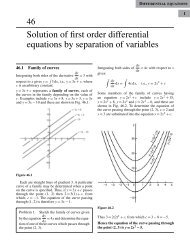vector
Create successful ePaper yourself
Turn your PDF publications into a flip-book with our unique Google optimized e-Paper software.
440 Vectors<br />
Solution.<br />
<br />
v =<br />
iˆ<br />
ˆj kˆ<br />
iˆ<br />
ˆj kˆ<br />
x y z<br />
y z x<br />
Obviously ˆn = k ˆ.<br />
Therefore<br />
<br />
( v)<br />
nˆ<br />
= (– iˆ<br />
– ˆj – kˆ). kˆ<br />
–1<br />
Hence<br />
( v)<br />
nds ˆ = ( 1) dx dy<br />
S<br />
=<br />
S<br />
<br />
S<br />
dx dy<br />
= – (1) 2 = – . (Area of circle = r 2 ) Ans.<br />
Example 90. Use Stoke’s Theorem to evaluate<br />
v ,<br />
c dr<br />
2<br />
where v y iˆ xyj ˆ xzkˆ<br />
, and c<br />
is the bounding curve of the hemisphere x 2 + y 2 + z 2 = 9, z > 0, oriented in the positive<br />
direction.<br />
Solution. By Stoke’s theorem<br />
<br />
( v)<br />
nds ˆ =<br />
S<br />
<br />
v <br />
c<br />
<br />
dr = (curl v) nˆ ds ( v)<br />
nds<br />
ˆ<br />
S S<br />
iˆ<br />
ˆj kˆ<br />
ˆ ˆ<br />
ˆ<br />
(0 0) i ( z 0) j ( y 2 y)<br />
k<br />
v =<br />
x y z zj ˆ ykˆ<br />
2<br />
y xy xz<br />
2 2 2<br />
<br />
i j k ( x y z 9)<br />
ˆn = | = x y z<br />
|<br />
| |<br />
=<br />
2 xiˆ 2 yj ˆ 2 zkˆ xiˆ yj ˆ zkˆ xiˆ yj ˆ zkˆ<br />
<br />
<br />
2 2 2 2 2 2<br />
4x 4y 4 z x y z 3<br />
<br />
ˆ ˆ ˆ<br />
( v)<br />
nˆ<br />
2<br />
= ( ˆ ˆ xi yj zk yz yz yz<br />
zj yk)<br />
<br />
3 3 3<br />
ˆ ˆ ˆ<br />
ˆn<br />
kds ˆ = dx dy <br />
xi yj zk . k ˆ<br />
z<br />
dx = dx dy ds = dx dy<br />
3<br />
3<br />
ds = 3 dx dy<br />
z<br />
<br />
2yz<br />
3<br />
<br />
dx dy = 2 ydxdy<br />
3 z <br />
<br />
=<br />
= 2r sin r d dr<br />
3<br />
3<br />
2 r <br />
0<br />
0<br />
<br />
2<br />
3<br />
<br />
2 sin d r dr<br />
<br />
0 0<br />
= 2( cos )<br />
= – 2 (– 1 + 1) 9 = 0 Ans.<br />
3 <br />
Example 91. Evaluate the surface integral curl F . nˆ<br />
dS by transforming it into a line<br />
S<br />
integral, S being that part of the surface of the paraboloid z = 1 – x 2 – y 2 for which<br />
<br />
z0and<br />
F yiˆ<br />
zj ˆ xkˆ<br />
. (K. University, Dec. 2008)<br />
<br />
2










